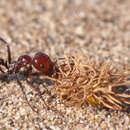en
names in breadcrumbs


Notes:
Taxonomy of the genus Messor , particularly in Europe, is poorly resolved and many taxonomic problems need further elaboration. Therefore (see below) we left all the species names recorded by previous authors without comments, but we stress that many of the records need confirmation.
These are granivorous ants whose nest entrances are usually surrounded by conspicuous piles of seed chaff. The seven California species are found mostly in open, dry habitats. There is some evidence that the Nearctic species of Messor are more closely related to a group of New World Aphaenogaster (those belonging to the erstwhile genus Novomessor ) than to the Old World species of Messor (Bennett 2000). If confirmed this would warrant redefinition of Messor and resurrection of Veromessor , the genus name previously applied to the Nearctic species. Unfortunately Aphaenogaster itself is likely to be paraphyletic and a comprehensive overhaul of the entire tribe Pheidolini , in which these ants have been placed, is needed.
Species identification: keys in Smith (1956a) and Wheeler and Wheeler (1986g). Additional references: Bennett (2000), Boulton et al. (2003), Brown (1999a, 1999b), Brown and Human (1997), Cahan et al. (1998), Cole (1963a), Creighton (1953a), Davidson(1977a, 1978), Helms Cahan (2001), Hobbs (1985), Johnson (2000a, 2001), O’Dowd and Hay (1980), Rissing and Wheeler (1976), Ryti and Case (1988), Waser (1998), Went et al. (1972), Wheeler and Rissing (1975a, 1975b), Wheeler and Creighton (1934).
Messor Forel, 1890: Annls Soc. Ent. Belg. 34.C.R:68.
Type-species: Formica barbara L. , 1767, Syst. Nat. ed.12, 2:962.
Distribution: Palaearctic, Ethiopian, Oriental, Nearctic & Neotropical regions.
Key to species
1 - Underside of head with moderately curved and straight hairs (Fig.32); head reddish-yellow ..................... M. rufotestaceous (Foerster)
- Underside of head with at least some long J- shaped hairs (Fig.33), head black..............2
2- Propodeum armed with a triangular teeth, body entirely black, dorsum of propodeum completely straited; petiole with 3 pairs of hairs(Fig.34)............... M. foreli Santschi .
-Propodeum unarmed, body entirely black except antenna and pronotum reddish, dorsum of alitrunk completely striated; presence of one pair of hairs on petiole (Fig.35)............ .............................. M. ebininus Santschi
André a fait ressortir avec raison que les Aphaenogaster moissonneurs se distinguent des Aphaenogaster chasseurs non seulement par leurs mœurs , mais par la conformation de leurs mandibules qui sont courtes, épaisses et fortement courbées , ainsi que surtout par le „ diraorphisme partiel de l'ouvrière ([[worker]] major à grosse tête ). Chez les Aphaenogaster chasseurs (dont les mœurs carnivores ont étédémontrées par Emery) l'ouvrière est au contraire aussi constante que chez les Myrmica . Ces deux moitiés du genre sont au moins aussi distinctes que beaucoup de genres de Myrmicides, aussi je propose de former un sous-genre " Messor " pour les Aphaenogaster moissonneurs , réservant le nom d' Aphaenogaster proprement dit pour les Aphaenogaster chasseurs auxquels il fut d'abord appliqué .
Messor is a myrmicine genus of ants with more than 100 species, all of which are harvester ants; the generic name comes from the Roman god of crops and harvest, Messor. The subterranean colonies tend to be found in open fields and near roadsides, openings are directly to the surface.
Colonies can achieve huge sizes and are notable for their intricately designed granaries in which seeds are stored in dry conditions, preventing germination. The structure of Messor spp. nests is complex and the genus on the whole is one of very accomplished architects.
Messor spp. are polymorphic and have a distinct caste of macrocephalic dinoergates whose role is carrying and cutting the large seeds which comprise much of the colonies' subsistence. Although they primarily feed on seeds, they occasionally eat insects and snails. Some snail shells possibly are taken into the nest because of their grain-like shape.[2]
Equipped with a tough, shining cuticle, Messor spp. are slow-moving and form long, seed-carrying runs. Colonies tend to be monogynous - founded by a single queen alone.
Looking specifically at the M. arenarius species for example, like some other types of harvester ants, they emit trail pheromones as well as operating on an individual level when looking for food sources.[3]
Messor is a myrmicine genus of ants with more than 100 species, all of which are harvester ants; the generic name comes from the Roman god of crops and harvest, Messor. The subterranean colonies tend to be found in open fields and near roadsides, openings are directly to the surface.
Colonies can achieve huge sizes and are notable for their intricately designed granaries in which seeds are stored in dry conditions, preventing germination. The structure of Messor spp. nests is complex and the genus on the whole is one of very accomplished architects.
Messor spp. are polymorphic and have a distinct caste of macrocephalic dinoergates whose role is carrying and cutting the large seeds which comprise much of the colonies' subsistence. Although they primarily feed on seeds, they occasionally eat insects and snails. Some snail shells possibly are taken into the nest because of their grain-like shape.
Equipped with a tough, shining cuticle, Messor spp. are slow-moving and form long, seed-carrying runs. Colonies tend to be monogynous - founded by a single queen alone.
Looking specifically at the M. arenarius species for example, like some other types of harvester ants, they emit trail pheromones as well as operating on an individual level when looking for food sources.